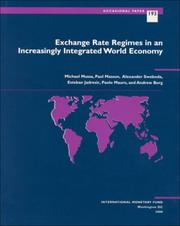| Listing 1 - 4 of 4 |
Sort by
|
Book
ISBN: 1455246859 1455212466 1451974116 Year: 2000 Publisher: Washington, D.C. : International Monetary Fund,
Abstract | Keywords | Export | Availability | Bookmark
 Loading...
Loading...Choose an application
- Reference Manager
- EndNote
- RefWorks (Direct export to RefWorks)
Since beginning economic transition, the Czech Republic, Estonia, Hungary, Poland, and Slovenia have—with much success—employed diverse exchange rate regimes. As these countries approach EU accession, they will need to avoid the perils of too much or too little exchange rate variability when capital flows are likely to be large and volatile; narrow band arrangements in particular could be problematic. The exception is Estonia, where there are good arguments for retaining the currency board arrangement. Countries wishing to join the euro area at an early stage should not leave the removal of remaining capital controls to the last minute.
Foreign Exchange --- Inflation --- Monetary Systems --- Standards --- Regimes --- Government and the Monetary System --- Payment Systems --- Monetary Policy --- Central Banks and Their Policies --- International Monetary Arrangements and Institutions --- Development Planning and Policy: Trade Policy --- Factor Movement --- Foreign Exchange Policy --- Price Level --- Deflation --- Currency --- Foreign exchange --- Macroeconomics --- Exchange rates --- Exchange rate arrangements --- Exchange rate flexibility --- Exchange rate policy --- Prices --- Czech Republic

ISBN: 9781451970180 1451970188 1557759707 9781557759702 1462310877 1452722099 1283538385 9786613850836 Year: 2000 Publisher: Washington, D.C. : International Monetary Fund,
Abstract | Keywords | Export | Availability | Bookmark
 Loading...
Loading...Choose an application
- Reference Manager
- EndNote
- RefWorks (Direct export to RefWorks)
This pamphlet is adapted from Chapter 1 of Silent Revolution: The International Monetary Fund, 1979-89, by the same author. That book is full of history of the evolution of the Fund during 11 years in which the institution truly came of age as a participant in the international financial system.
International finance. --- International monetary system --- International money --- Finance --- International economic relations --- International Monetary Fund. --- Internationaal monetair fonds --- International monetary fund --- Exports and Imports --- Financial Risk Management --- Foreign Exchange --- Inflation --- Financial Crises --- Price Level --- Deflation --- International Lending and Debt Problems --- Development Planning and Policy: Trade Policy --- Factor Movement --- Foreign Exchange Policy --- Currency --- Foreign exchange --- Economic & financial crises & disasters --- Macroeconomics --- International economics --- Financial crises --- Exchange rates --- Debt default --- Exchange rate policy --- External debt --- Prices --- Debts, External --- United States
Book
ISBN: 1462349897 1452773424 1282109367 1451901356 9786613802255 Year: 2000 Publisher: Washington, D.C. : International Monetary Fund,
Abstract | Keywords | Export | Availability | Bookmark
 Loading...
Loading...Choose an application
- Reference Manager
- EndNote
- RefWorks (Direct export to RefWorks)
This paper studies the impact effect of monetary policy shocks—identified by the reaction of three month market interest rates to policy announcements—on the exchange rate in Australia, Canada, and New Zealand during the 1990s. The main results are that (1) on average, a 100 basis point contractionary shock will appreciate the exchange rate by 2-3 percent on impact; (ii) seemingly “perverse” reactions of the exchange rate to monetary policy are mainly attributable to reverse causality; (iii) in a few instances, there were true “perverse” reactions of exchange rates to policy— generally, appreciations following expansionary shocks.
Banks and Banking --- Foreign Exchange --- Investments: General --- Money and Monetary Policy --- Monetary Policy --- Central Banks and Their Policies --- Open Economy Macroeconomics --- Development Planning and Policy: Trade Policy --- Factor Movement --- Foreign Exchange Policy --- Interest Rates: Determination, Term Structure, and Effects --- Monetary Systems --- Standards --- Regimes --- Government and the Monetary System --- Payment Systems --- Investment --- Capital --- Intangible Capital --- Capacity --- Currency --- Foreign exchange --- Banking --- Monetary economics --- Macroeconomics --- Exchange rates --- Exchange rate policy --- Central bank policy rate --- Currencies --- Depreciation --- Financial services --- Money --- National accounts --- Interest rates --- Saving and investment --- New Zealand


ISBN: 1557758921 1462360289 1452713669 9781557758927 Year: 2000 Volume: 193 Publisher: Washington (D.C.) IMF
Abstract | Keywords | Export | Availability | Bookmark
 Loading...
Loading...Choose an application
- Reference Manager
- EndNote
- RefWorks (Direct export to RefWorks)
This paper examines the consequences of heightened capital mobility and of the integration of developing economies in increasingly globalized markets for the exchange rate regimes of the industrial, developing, and transition economies. It builds upon previous studies by IMF staff on various aspects of the exchange rate arrangements of member countries, consistent with the IMF's role of surveillance over its members exchange rate policies.
Zonder onderwerpscode --- Foreign exchange --- Foreign exchange administration --- International economic relations --- economie --- economisch beleid --- handel --- wereld --- 339.9 --- 339.7 --- AA* / International - Internationaal --- 333.825 --- 333.450 --- 330.05 --- 332.45 --- Economic policy, Foreign --- Economic relations, Foreign --- Economics, International --- Foreign economic policy --- Foreign economic relations --- Interdependence of nations --- International economic policy --- International economics --- New international economic order --- Economic policy --- International relations --- Economic sanctions --- Buitenlandse economische betrekkingen. Internationale economische betrekkingen --- Internationale financien. Buitenlands betalingsverkeer --(z.o {336}) --- Deviezenpolitiek. Interventies. --- Theorie van het deviezenverkeer. Theorie van de koopkrachtpariteit. --- Working papers --- Foreign exchange administration. --- Foreign exchange. --- International economic relations. --- Internationale economische betrekkingen --- Wisselkoersen --- Internationale economische betrekkingen. --- Wisselkoersen. --- 339.7 Internationale financien. Buitenlands betalingsverkeer --(z.o {336}) --- 339.9 Buitenlandse economische betrekkingen. Internationale economische betrekkingen --- Cambistry --- Currency exchange --- Exchange, Foreign --- Foreign currency --- Foreign exchange problem --- Foreign money --- Forex --- FX (Finance) --- International exchange --- International finance --- Currency crises --- Theorie van het deviezenverkeer. Theorie van de koopkrachtpariteit --- Deviezenpolitiek. Interventies --- Exports and Imports --- Finance: General --- Foreign Exchange --- Money and Monetary Policy --- Monetary Systems --- Standards --- Regimes --- Government and the Monetary System --- Payment Systems --- General Financial Markets: General (includes Measurement and Data) --- Development Planning and Policy: Trade Policy --- Factor Movement --- Foreign Exchange Policy --- Financial Aspects of Economic Integration --- Currency --- Monetary economics --- Finance --- Exchange rates --- Exchange rate arrangements --- Currencies --- Emerging and frontier financial markets --- Exchange rate policy --- Financial markets --- Money --- Financial services industry --- Monetary unions --- United States
| Listing 1 - 4 of 4 |
Sort by
|

 Search
Search Feedback
Feedback About UniCat
About UniCat  Help
Help News
News